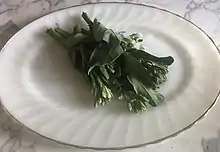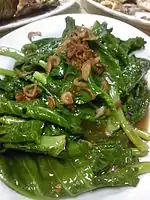Gai lan
Gai lan, kai-lan, Chinese broccoli,[1] or Chinese kale (Brassica oleracea var. alboglabra)[2] is a leafy vegetable with thick, flat, glossy blue-green leaves with thick stems, and florets similar to (but much smaller than) broccoli. A Brassica oleracea cultivar, gai lan is in the group alboglabra (from Latin albus "white" and glabrus "hairless"). When gone to flower, its white blossoms resemble that of its cousin Matthiola incana or hoary stock. The flavor is very similar to that of broccoli, but noticeably stronger and slightly more bitter.[3]
| Gai lan | |
|---|---|
 Gai lan | |
| Species | Brassica oleracea |
| Cultivar group | Alboglabra Group |
| Origin | unknown |
| Gai lan | |||||||||||||||||||||||
|---|---|---|---|---|---|---|---|---|---|---|---|---|---|---|---|---|---|---|---|---|---|---|---|
.svg.png.webp) "Gai lan" in Traditional (top) and Simplified (bottom) Chinese characters | |||||||||||||||||||||||
| Chinese name | |||||||||||||||||||||||
| Traditional Chinese | 芥蘭 | ||||||||||||||||||||||
| Simplified Chinese | 芥兰 | ||||||||||||||||||||||
| Hanyu Pinyin | jièlán | ||||||||||||||||||||||
| Jyutping | gaai3 laan4*2 | ||||||||||||||||||||||
| Literal meaning | mustard orchid | ||||||||||||||||||||||
| |||||||||||||||||||||||
| Burmese name | |||||||||||||||||||||||
| Burmese | ကိုက်လန် | ||||||||||||||||||||||
| Vietnamese name | |||||||||||||||||||||||
| Vietnamese | cải làn or cải rổ | ||||||||||||||||||||||
| Thai name | |||||||||||||||||||||||
| Thai | คะน้า [kʰā.náː] | ||||||||||||||||||||||
| RTGS | khana | ||||||||||||||||||||||
| Khmer name | |||||||||||||||||||||||
| Khmer | ខាត់ណា | ||||||||||||||||||||||
Hybrids
Broccolini is a hybrid between broccoli and gai lan.[4]
Cultivation
Gai lan is a cool season crop that grows best between 18 and 28 °C (64 and 82 °F). It withstands hotter summer temperatures than other brassicas such as broccoli or cabbage. Gai lan is harvested around 60-70 days after sowing, just before the flowers start to bloom. The stems can become woody and tough when the plant bolts.[5]
Uses
Culinary
Gai lan is eaten widely in Chinese cuisine; common preparations include gai lan stir-fried with ginger and garlic, and boiled or steamed and served with oyster sauce. It is also common in Vietnamese, Burmese and Thai cuisine.[3]
In Americanized Chinese food (like beef and broccoli),[6] gai lan was frequently replaced by broccoli, when gai lan was not available.[7]
 Gai lan
Gai lan Baby gai lan served Cantonese-style
Baby gai lan served Cantonese-style Phat khana mu krop: Thai-style fried Chinese broccoli with crispy pork belly
Phat khana mu krop: Thai-style fried Chinese broccoli with crispy pork belly
References
- Patrick J. Cummings; Hans-Georg Wolf (2011). A Dictionary of Hong Kong English: Words from the Fragrant Harbor. Hong Kong University Press. p. 62. ISBN 9789888083305.
- "Brassica oleracea L. var. alboglabra (L. H. Bailey) Musil". Germplasm Resources Information Network. Agricultural Research Service, United States Department of Agriculture. Retrieved 23 August 2016.
- "Kai-lan - Cuisine of Myanmar (Burma)". Trek Zone. Retrieved 2023-05-10.
- "Broccolini". Washington State University. Retrieved 2018-08-14.
- Rana, M. K.; Reddy, P. Karthik (2018). Vegetable Crop Science (1st ed.). CRC Press. pp. 289–298. ISBN 978-1138035218.
- "History and Culture: Chinese Food | New University | UC Irvine". 2008-06-02. Retrieved 2023-05-23.
- Hung, Melissa (2019-10-31). "When authenticity means a heaping plate of Tex-Mex". San Francisco Chronicle. Retrieved 2019-11-05.
- "Chinese Kale (Gai Lan, Chinese Broccoli)". Evergreen Seeds. Retrieved 6 February 2013.
- How To Stir-Fry Chinese Broccoli
External links
 Media related to Gai lan at Wikimedia Commons
Media related to Gai lan at Wikimedia Commons